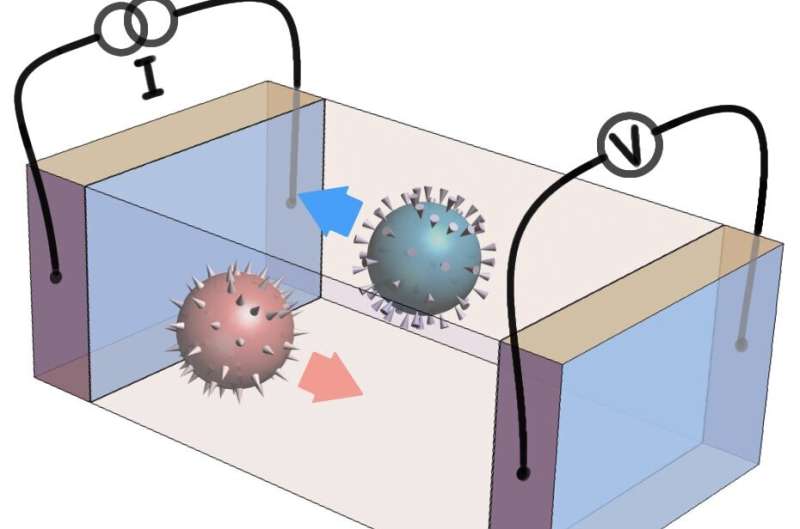January 18, 2021 feature
The long-range transport of deconfined magnetic hedgehogs

Spintronics is an emerging area of research that aims to develop devices that transmit, process and store information leveraging the intrinsic angular momentum of electrons, known as spin. A key objective of spintronics studies is to identify strategies to use magnetic insulators to achieve the transport of signals over long distances.
Magnetic insulators are a class of materials widely used worldwide, mainly due to their ability to conduct electrical charges. Just like metals conduct electrical charges, magnetic insulators can conduct spins. Nonetheless, as spins are rarely conserved in materials and tend to disappear over long distances, so far, using magnetic insulators to achieve long-range transport has proved highly challenging.
Researchers have recently demonstrated the long-range transport of magnetic hedgehogs, 3-D topological spin structures that are often observed in common magnets. Their work, outlined in a paper published in Physical Review Letters, could have important implications for the development of spintronic devices.
"Our idea is to resort to topological spin textures rather than spins themselves for the purpose of long-range transport," Shu Zhang, one of the researchers who carried out the study, told Phys.org. "The magnetic hedgehog is one type of topologically protected spin texture that generically exits in three-dimensional magnets. Our work shows that the hedgehog current is a well conserved quantity and can be explored to achieve long-range transport in magnetic insulators."
The recent study by Zhang and her colleagues is based on a theoretical construct known as the topological conservation law, which allowed the researchers to leverage the idea of hydrodynamics of topological spin textures. This idea has previously been explored in a series of studies led by physicist Yaroslav Tserkovnyak.
"The main theoretical approach we applied in our study is classical field theory," Zhang explained. "We describe the space-time distribution of the spins as a continuous vector field, on top of which the topological textures and their currents can be defined and studied. We found that the mathematical description of the hedgehog currents actually bears an analogy to the most renowned field theory, that of electromagnetism."
When they set out to investigate long-range transport, Zhang and her colleagues specifically considered a 'typical' experimentally feasible setup, in which a hedgehog's current is injected and detected using metal contacts attached to the two ends of a magnet. In their paper, they propose that in this scenario, a magnet could be seen as a conductor that transports the current of topological spin textures with a finite conductance. This idea ultimately highlights the potential of using magnetic insulators to achieve transport over long distances.
"I think it is very exciting to envision the possibility that regular magnetic insulators can be used for long-range transport," Zhang said. "This will make the realization of various spin circuitries possible with high energy efficiency because of the absence of Joule heating."
In the future, the study could inspire other research teams to investigate the transport dynamics of topological spin textures further, particularly those of magnetic hedgehogs, which are widely available. The development of effective strategies to control these dynamics would ultimately open up new possibilities for enabling the long-distance transmission of information in spintronic devices using 3-D magnetic materials.
"We hope to see our ideas tested in experiments soon," Zhang said. "Our current work is based on classical or semiclassical considerations of spins. In the future, it would be interesting to see how topological spin textures could contribute to the transport in quantum magnets."
More information: Topological transport of deconfined hedgehogs in magnets. Physical Review Letters(2021). DOI: 10.1103/PhysRevLett.125.267201
Journal information: Physical Review Letters
© 2021 Science X Network





















